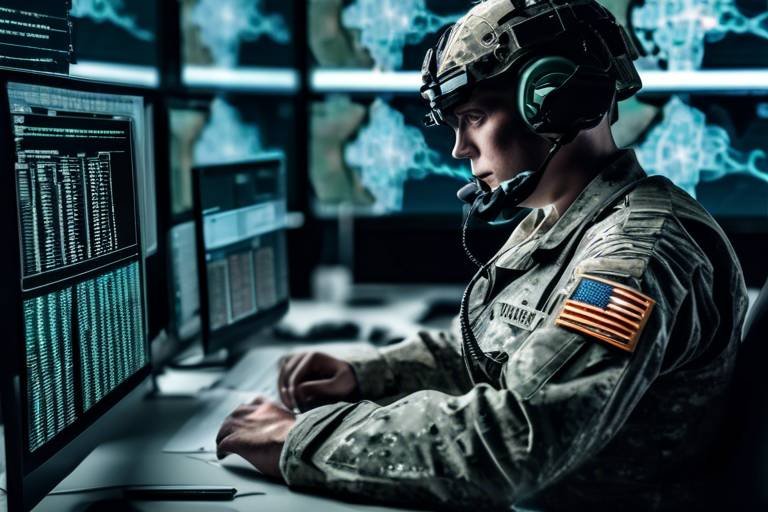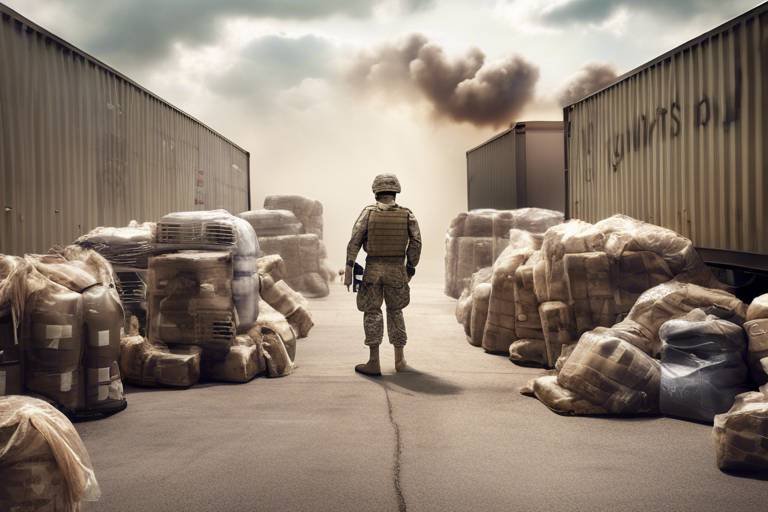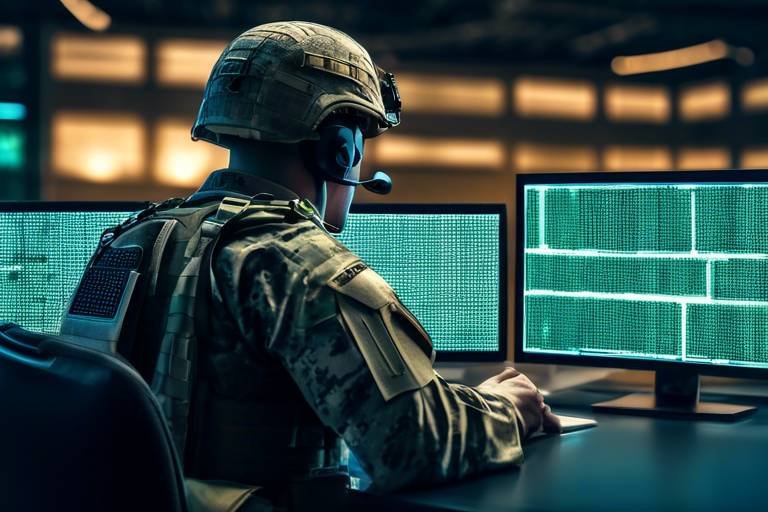How AI Algorithms Are Transforming Battlefield Surveillance
In recent years, the landscape of military operations has undergone a dramatic transformation, largely thanks to the advent of AI algorithms. These sophisticated systems are not just a trend; they represent a monumental shift in how battlefield surveillance is conducted. Imagine a world where soldiers can access real-time data, analyze it on the fly, and make informed decisions in the blink of an eye. This is no longer the stuff of science fiction; it's happening right now. AI algorithms are enhancing situational awareness, improving data analysis, and streamlining decision-making processes. In this article, we'll delve into how these technologies are reshaping the battlefield and the implications that come along with it.
One of the most significant advantages of AI algorithms in battlefield surveillance is their capability for enhanced data processing. Traditional surveillance systems often struggle to keep up with the sheer volume of information generated during military operations. However, with AI, military personnel can analyze vast amounts of data in real-time. This means that critical information can be processed and acted upon almost instantaneously. Think of it like having a supercharged brain that can sift through mountains of data, extracting only the most relevant insights. This not only boosts operational efficiency but also enhances the overall effectiveness of military strategies.
Another groundbreaking application of AI in battlefield surveillance is in target recognition. The integration of AI allows for advanced capabilities that help distinguish between combatants and non-combatants effectively. This is crucial in reducing collateral damage, a significant concern in modern warfare. AI systems use complex algorithms to analyze visual data, making it possible to identify potential threats with remarkable accuracy. Imagine a scenario where a drone can differentiate between a soldier and a civilian in an urban environment; this capability is invaluable in preserving innocent lives while still achieving mission objectives.
At the heart of these advancements are machine learning techniques. These systems learn from historical data, improving their ability to identify patterns and predict potential threats in battlefield environments. Over time, they become smarter and more efficient, adapting to new challenges and scenarios. It's like training a dog; the more you teach it, the better it gets at obeying commands. In this case, the 'commands' are the various patterns and behaviors that military personnel need to recognize in the heat of battle.
Furthermore, deep learning models play a pivotal role in enhancing image and video analysis. These models allow for more precise identification of objects and activities on the battlefield, thus aiding strategic planning. With the ability to process complex visual data, deep learning can help military strategists make informed decisions based on real-time analysis. For instance, if a deep learning model detects unusual troop movements, commanders can quickly adapt their strategies to counter potential threats.
Moreover, neural networks can analyze complex datasets, recognizing subtle changes in the environment that may indicate enemy movement or activity. This capability is akin to having a highly trained scout who can notice the smallest details that others might overlook. By providing this level of insight, neural networks empower military forces to act swiftly and decisively, potentially turning the tide of battle.
AI-driven surveillance systems facilitate real-time decision-making by providing commanders with actionable insights. In fast-paced military operations, the ability to respond quickly is crucial. AI systems can analyze incoming data and present it in a way that allows commanders to make informed decisions almost instantaneously. This responsiveness is essential in dynamic battlefield conditions, where every second counts. Imagine being able to assess a situation and deploy resources effectively within moments—this is the power of AI.
The deployment of AI-powered drones in surveillance operations offers a cost-effective solution for monitoring vast areas. These drones provide critical intelligence without risking human lives, making them an invaluable asset in modern warfare. With the ability to cover large terrains quickly, they can gather data that would take ground troops significantly longer to obtain.
AI-powered drones come equipped with autonomous flight capabilities, allowing them to navigate complex terrains and adapt to changing environments. This ensures continuous surveillance and data collection, even in challenging conditions. Imagine a drone that can fly itself over a mountain range, dodging obstacles while capturing vital intelligence—this is the future of battlefield surveillance.
Additionally, data fusion techniques integrate information from multiple sources, enhancing the overall situational awareness and operational effectiveness of military forces on the ground. By synthesizing data from various platforms—such as satellites, drones, and ground sensors—military commanders can gain a comprehensive view of the battlefield. This holistic perspective is crucial for making informed operational decisions.
However, the use of AI in battlefield surveillance raises important ethical considerations. Questions regarding privacy, accountability, and the potential for misuse necessitate a careful examination of its implications in military contexts. As we embrace these technologies, we must also consider the moral responsibilities that come with them. How do we ensure that AI is used responsibly and ethically? This is a conversation that must continue as we move forward.
- How does AI improve battlefield surveillance? AI enhances data processing, improves target recognition, and facilitates real-time decision-making, making military operations more effective.
- What role do drones play in surveillance? AI-powered drones provide critical intelligence while minimizing risks to human lives, allowing for extensive monitoring of battlefield areas.
- What are the ethical concerns surrounding AI in military operations? Ethical concerns include privacy issues, accountability for actions taken by AI systems, and the potential for misuse in warfare.

Enhanced Data Processing
In the fast-evolving landscape of military operations, AI algorithms are revolutionizing the way data is processed, leading to unprecedented improvements in battlefield surveillance. Imagine trying to sift through mountains of information in a matter of seconds—this is precisely what AI enables military personnel to do. By leveraging advanced algorithms, they can analyze vast amounts of data in real-time, transforming raw information into actionable insights. This capability is not just about speed; it’s about accuracy and efficiency, allowing commanders to make informed decisions that could mean the difference between success and failure on the battlefield.
The integration of AI into surveillance systems brings forth a new era of . Traditional methods often struggle to keep up with the sheer volume of data generated during military operations. However, AI can process this information at lightning speed, identifying critical patterns and anomalies that would typically go unnoticed. For instance, AI algorithms can analyze various data sources, such as satellite imagery, drone footage, and sensor readings, to create a comprehensive picture of the battlefield.
Moreover, the ability to process data in real-time means that military personnel can respond to threats as they emerge. This is akin to having a supercharged brain that can recall past experiences and apply them to current situations, thereby improving the decision-making process. The implications of this are profound, as it allows for a level of situational awareness that was previously unattainable.
To illustrate the impact of enhanced data processing, consider the following table that outlines the differences between traditional and AI-driven data processing methods:
| Aspect | Traditional Data Processing | AI-Driven Data Processing |
|---|---|---|
| Speed | Slow, manual analysis | Real-time processing |
| Accuracy | Prone to human error | High accuracy with machine learning |
| Data Sources | Limited integration | Multi-source data fusion |
| Response Time | Delayed reactions | Immediate actionable insights |
As we delve deeper into the capabilities of AI, it’s essential to understand that the algorithms are not merely tools; they are evolving entities that learn and adapt over time. This means that the more data they process, the better they become at identifying potential threats and opportunities. It’s like training a dog—initially, it may not understand commands, but with consistent training and feedback, it becomes a reliable companion. Similarly, AI algorithms refine their abilities, ultimately enhancing the overall effectiveness of military operations.
In conclusion, enhanced data processing through AI algorithms is a game-changer for battlefield surveillance. By improving speed, accuracy, and the ability to analyze complex datasets, military personnel can achieve a level of situational awareness that significantly enhances their operational effectiveness. As we continue to explore the potential of AI in military contexts, it is clear that this technology is not just an advancement; it is a necessity for modern warfare.
- How does AI improve data processing in military surveillance? AI enhances data processing by enabling real-time analysis of large datasets, allowing for quicker and more accurate decision-making.
- What types of data can AI algorithms analyze? AI can analyze various types of data, including satellite imagery, drone footage, and sensor readings, integrating them for a comprehensive view of the battlefield.
- Are there any risks associated with using AI in military surveillance? Yes, while AI provides numerous benefits, there are ethical considerations regarding privacy, accountability, and the potential for misuse that must be addressed.

Improved Target Recognition
In the ever-evolving landscape of modern warfare, target recognition has emerged as a pivotal factor in ensuring the success of military operations. With the integration of AI algorithms into battlefield surveillance systems, the ability to distinguish between combatants and non-combatants has reached unprecedented levels of accuracy. Imagine a world where drones equipped with advanced AI can identify threats with the precision of a hawk spotting its prey from miles away. This leap in technology not only enhances operational effectiveness but also plays a crucial role in minimizing collateral damage.
One of the standout features of AI-driven surveillance is its capacity to analyze vast amounts of data in real-time, allowing military personnel to make informed decisions swiftly. With the power of machine learning, these systems can learn from historical data, enabling them to identify patterns and predict potential threats. This is akin to a seasoned detective who, after years of experience, can read a crime scene like a book. The more data these systems process, the better they become at recognizing subtle indicators of hostile activity.
To delve deeper into the mechanics of improved target recognition, let’s explore some of the key technologies at play:
- Machine Learning Techniques: These algorithms allow systems to adapt and improve over time, enhancing their ability to classify objects and activities accurately.
- Deep Learning Models: By processing large datasets of images and videos, deep learning enhances the precision of target identification, making it possible to differentiate between similar-looking objects.
- Neural Networks: These models can analyze complex datasets, recognizing intricate patterns that might go unnoticed by the human eye.
For example, consider a scenario where a surveillance drone is monitoring a conflict zone. The AI system, trained on thousands of hours of footage, can instantly determine whether a group of individuals is engaged in hostile actions or merely going about their daily lives. This capability is not just about identifying threats; it’s about understanding the context and making decisions that could save lives.
Moreover, the integration of AI in target recognition systems has significant implications for strategic planning. Commanders can rely on accurate data to allocate resources effectively, deploy troops where they are most needed, and ultimately, devise strategies that align with real-time developments on the battlefield. The ability to recognize targets accurately and swiftly can mean the difference between mission success and failure.
However, as with any powerful tool, there are challenges and ethical considerations to navigate. The potential for misidentification remains a concern, and the implications of erroneous strikes can be devastating. Thus, while AI enhances our capabilities, it also necessitates a robust framework for accountability and oversight.
- How does AI improve target recognition? AI improves target recognition through machine learning and deep learning techniques that analyze vast datasets, allowing for real-time identification of threats.
- What are the risks associated with AI in military operations? Risks include potential misidentification of targets, ethical concerns regarding accountability, and the possibility of misuse.
- Can AI systems operate autonomously? Yes, AI systems can operate autonomously, but human oversight is crucial to ensure ethical decision-making and accountability.

Machine Learning Techniques
Machine learning techniques are at the forefront of transforming battlefield surveillance, acting as the brain behind the operations of advanced surveillance systems. Imagine a world where machines can learn from past experiences, just like we do. This capability allows them to analyze historical data, identify patterns, and make predictions about potential threats in real-time. It’s like having a seasoned military strategist who never forgets a battle, constantly refining their strategies based on previous encounters.
One of the most compelling aspects of machine learning is its ability to process and analyze vast amounts of data at lightning speed. In a battlefield scenario, this means that surveillance systems can sift through countless images, videos, and sensor data to detect anomalies that might indicate enemy movements. For instance, if a surveillance system has been trained on data from previous conflicts, it can recognize what typical troop movements look like and flag anything that deviates from this norm. This predictive capability is not just a luxury; it’s a necessity for effective military operations.
Furthermore, machine learning algorithms can be categorized into various types, each serving a unique purpose in enhancing surveillance capabilities:
- Supervised Learning: This involves training the algorithm on labeled datasets, where the system learns to predict outcomes based on input data. For example, if the system is shown images of vehicles labeled as "friendly" or "hostile," it can learn to classify new images accordingly.
- Unsupervised Learning: In this approach, the algorithm analyzes data without predefined labels, seeking patterns or groupings. This can be particularly useful for detecting unusual behavior in a battlefield environment that may not fit into known categories.
- Reinforcement Learning: This technique allows algorithms to learn optimal actions through trial and error, similar to how a soldier learns from experience. In surveillance, this could mean adapting strategies based on the success or failure of previous missions.
Moreover, the integration of these machine learning techniques into battlefield surveillance not only enhances the accuracy of threat detection but also significantly reduces the cognitive load on human operators. By automating the analysis of data, military personnel can focus on strategic decision-making rather than getting bogged down in the minutiae of data interpretation. This leads to faster response times and improved operational effectiveness, which can be the difference between success and failure in critical situations.
In summary, machine learning techniques are revolutionizing how military forces approach battlefield surveillance. By harnessing the power of historical data and pattern recognition, these systems are becoming indispensable tools that enhance situational awareness and enable proactive decision-making. As we continue to refine these technologies, the potential for more sophisticated and effective surveillance systems is boundless, paving the way for a new era in military operations.
Q: How do machine learning algorithms improve battlefield surveillance?
A: Machine learning algorithms enhance battlefield surveillance by processing vast amounts of data quickly and accurately, identifying patterns, and predicting potential threats based on historical data.
Q: What are the main types of machine learning techniques used in surveillance?
A: The main types include supervised learning, unsupervised learning, and reinforcement learning, each serving unique functions in analyzing and interpreting data.
Q: Can machine learning reduce human error in military operations?
A: Yes, by automating data analysis, machine learning can significantly reduce the cognitive load on human operators, allowing them to focus on strategic decisions and minimizing the risk of human error.

Deep Learning Models
Deep learning models are a game-changer when it comes to battlefield surveillance. They act like a finely tuned radar, sifting through countless images and videos to pinpoint crucial details that might otherwise go unnoticed. Imagine trying to find a needle in a haystack; now, visualize a supercharged magnet that not only finds that needle but also categorizes it based on size, shape, and material. That’s the power of deep learning! These models utilize multi-layered neural networks that mimic the human brain's function, allowing them to process complex data with impressive speed and accuracy.
One of the standout features of deep learning is its ability to learn from vast datasets. This means that the more data these models are exposed to, the better they become at recognizing patterns and making predictions. For instance, when analyzing battlefield footage, a deep learning model can differentiate between a friendly vehicle and an enemy tank by recognizing subtle variations in shape, color, and movement. This capability not only enhances target identification but also significantly reduces the risk of collateral damage, a critical concern in military operations.
Moreover, deep learning models can adapt to new information, much like a seasoned detective who learns from each case. As they process more data, they refine their algorithms, improving their accuracy over time. This self-improvement is vital in dynamic battlefield environments where conditions can change rapidly. For instance, if a certain type of enemy drone begins to appear frequently in surveillance footage, the model can adjust its parameters to better detect and classify that specific threat, ensuring that military personnel are always one step ahead.
To illustrate the effectiveness of deep learning in battlefield surveillance, consider the following table that highlights key advantages:
| Advantage | Description |
|---|---|
| High Accuracy | Deep learning models can achieve high levels of precision in identifying objects and activities in complex environments. |
| Real-Time Processing | These models can analyze data in real-time, providing immediate insights for decision-makers. |
| Scalability | Deep learning systems can scale to handle vast amounts of data without a drop in performance. |
| Continuous Learning | They improve over time by learning from new data, adapting to evolving threats effectively. |
In summary, deep learning models are revolutionizing battlefield surveillance by enhancing the ability to analyze and interpret complex data. Their capacity to learn from experience, coupled with real-time processing capabilities, makes them indispensable tools for military operations. As technology continues to evolve, we can expect these models to become even more sophisticated, ultimately leading to smarter and safer military strategies.
- What are deep learning models? Deep learning models are algorithms that use multiple layers of neural networks to analyze and interpret complex data, mimicking the human brain's learning processes.
- How do deep learning models improve battlefield surveillance? They enhance target recognition and data analysis speed, allowing military personnel to make informed decisions quickly and accurately.
- Are there any ethical concerns with using deep learning in military operations? Yes, concerns include issues of privacy, accountability, and the potential for misuse of surveillance data.

Neural Networks in Action
Neural networks are truly the unsung heroes of modern battlefield surveillance. Imagine having a highly skilled assistant that never sleeps, tirelessly analyzing data and learning from every piece of information it encounters. That’s what neural networks do—they mimic the human brain's ability to learn and adapt, enabling military surveillance systems to process complex datasets with astonishing efficiency. With the ability to recognize patterns and make decisions based on vast amounts of data, neural networks are revolutionizing how military forces gather and interpret information.
One of the most remarkable aspects of neural networks is their capacity to detect subtle changes in the environment. For instance, they can analyze satellite imagery and identify minute alterations that might indicate enemy movement. This capability is akin to having a hawk's eye, spotting the slightest shift in the landscape that could signal an impending threat. By leveraging advanced algorithms, these networks continuously improve their accuracy, making them invaluable for real-time battlefield assessments.
Moreover, neural networks excel in tasks that involve image and video analysis. Consider a scenario where multiple surveillance cameras are monitoring a specific area. A neural network can process feeds from all these cameras simultaneously, identifying objects and activities with remarkable precision. This functionality is crucial for distinguishing between friend and foe, thus significantly reducing the risk of collateral damage. In fact, the integration of neural networks into surveillance systems is akin to upgrading from a basic flashlight to a high-definition night vision scope—everything becomes clearer, and the chances of making errors diminish.
To illustrate the effectiveness of neural networks, let’s look at a simple table comparing traditional analysis methods to neural network-driven analysis:
| Aspect | Traditional Methods | Neural Network Methods |
|---|---|---|
| Speed of Analysis | Slow, often manual | Real-time, automated |
| Pattern Recognition | Limited, relies on human input | Advanced, learns from data |
| Error Rate | Higher, prone to oversight | Lower, improves with training |
| Adaptability | Rigid, inflexible | Dynamic, continuously evolving |
As we can see, the advantages of neural networks are profound. They not only enhance the accuracy of battlefield surveillance but also provide military commanders with the insights they need to make informed decisions swiftly. In a world where every second counts, the ability to process and analyze data in real time can mean the difference between success and failure on the battlefield.
In conclusion, neural networks are not just a technological advancement; they represent a paradigm shift in how military operations are conducted. With their ability to learn, adapt, and analyze vast amounts of information, these systems are leading the charge toward a future where battlefield surveillance is more effective, efficient, and precise than ever before.
- What are neural networks? Neural networks are computational models inspired by the human brain that are used to recognize patterns and learn from data.
- How do neural networks improve battlefield surveillance? They enhance the speed and accuracy of data analysis, allowing for real-time decision-making and improved target recognition.
- Can neural networks reduce collateral damage? Yes, by accurately distinguishing between combatants and non-combatants, they help minimize unintended harm during military operations.
- What is the role of deep learning in neural networks? Deep learning is a subset of machine learning that uses neural networks with many layers to analyze complex data, improving object and activity recognition.

Real-Time Decision Making
The battlefield is an unpredictable environment where split-second decisions can mean the difference between victory and defeat. In this high-stakes arena, AI-driven surveillance systems are revolutionizing the way military commanders approach . By providing actionable insights at lightning speed, these systems enhance situational awareness and responsiveness to dynamic conditions on the ground.
Imagine a scenario where a commander is faced with rapidly changing circumstances. Traditional methods of data analysis can be slow, often leaving troops vulnerable or misinformed. However, with AI algorithms, the process of gathering, analyzing, and interpreting data occurs almost instantaneously. For instance, AI can process video feeds from drones, satellite imagery, and ground sensors all at once, synthesizing this information into a coherent picture of the battlefield. This allows commanders to make informed decisions based on the most current data available.
One of the key benefits of AI in real-time decision making is its ability to identify and prioritize threats. By employing advanced algorithms, these systems can assess the likelihood of various scenarios unfolding and suggest the best course of action. For example, if a group of unidentified vehicles is detected approaching a military base, the AI can analyze their speed, trajectory, and previous behavior to determine whether they pose a threat. This capability not only enhances operational efficiency but also minimizes risks to personnel.
Moreover, the integration of AI in decision-making processes facilitates collaboration among units. With real-time data being shared across platforms, different branches of the military can coordinate their actions more effectively. This interconnectedness ensures that everyone is on the same page, reducing the chances of miscommunication and errors. In essence, AI acts as a force multiplier, amplifying the effectiveness of human decision-making.
However, it's essential to recognize that while AI enhances decision-making, it does not replace the human element. Commanders still play a crucial role in interpreting the insights provided by AI systems. The combination of human intuition and AI analytics creates a powerful synergy that can lead to more informed and timely decisions. As we continue to explore the potential of AI in military applications, the focus remains on leveraging technology to augment human capabilities rather than replace them.
In conclusion, the integration of AI in real-time decision making is transforming battlefield operations. By providing commanders with timely and actionable insights, AI enhances situational awareness and improves the overall effectiveness of military strategies. As technology continues to evolve, the potential for AI to shape the future of warfare becomes increasingly evident.
- How does AI improve decision-making in military operations?
AI improves decision-making by analyzing vast amounts of data quickly, identifying patterns, and providing actionable insights that help commanders respond to battlefield conditions effectively.
- Can AI completely replace human decision-making in the military?
No, while AI enhances decision-making capabilities, it is designed to support human judgment rather than replace it. The combination of AI analytics and human intuition is crucial for effective military operations.
- What are the risks associated with AI in military decision-making?
Risks include over-reliance on technology, potential errors in data interpretation, and ethical concerns surrounding accountability and transparency in military actions.

Automated Surveillance Drones
The deployment of AI-powered drones in battlefield surveillance represents a significant leap forward in military technology. These drones are not just flying cameras; they are sophisticated machines equipped with advanced algorithms that enable them to perform complex tasks autonomously. Imagine having a bird's-eye view of the battlefield, where every movement is monitored, and every potential threat is identified in real-time. This capability not only enhances the effectiveness of military operations but also drastically reduces the risks to human life.
One of the most remarkable features of these drones is their autonomous flight capabilities. Unlike traditional aircraft that require constant human control, AI-driven drones can navigate complex terrains and adjust their flight paths based on changing environmental conditions. This means they can operate in areas that are challenging for human pilots, such as densely forested regions or urban environments filled with obstacles. With their ability to fly without direct human intervention, these drones ensure continuous surveillance and data collection, allowing military personnel to focus on strategic decision-making rather than routine monitoring.
Moreover, the integration of data fusion techniques in these drones takes surveillance to the next level. By combining data from multiple sensors—such as infrared cameras, radar, and traditional video feeds—these systems create a comprehensive picture of the battlefield. This process not only enhances situational awareness but also improves operational effectiveness, as commanders can make informed decisions based on a holistic view of the environment. For instance, if a drone detects unusual movement patterns in a specific area, it can alert ground forces to investigate further, potentially intercepting threats before they escalate.
Consider the following table that outlines the key benefits of automated surveillance drones:
| Feature | Benefit |
|---|---|
| Autonomous Navigation | Reduces the need for human pilots, minimizing risk. |
| Real-Time Data Collection | Provides immediate intelligence to ground forces. |
| Data Fusion | Enhances situational awareness through integrated information. |
| Cost-Effectiveness | Offers a budget-friendly solution for extensive surveillance. |
In summary, automated surveillance drones are revolutionizing how military operations are conducted. With their ability to operate independently and gather critical intelligence, they play a crucial role in enhancing battlefield awareness and ensuring the safety of personnel. As technology continues to advance, we can only expect these systems to become even more capable, further transforming the landscape of military surveillance.
- What are automated surveillance drones? Automated surveillance drones are unmanned aerial vehicles equipped with AI technology that allows them to monitor and gather intelligence autonomously.
- How do these drones enhance battlefield operations? They provide real-time data collection, reduce risks to human life, and improve situational awareness through advanced data fusion techniques.
- Are there ethical concerns associated with using drones in military operations? Yes, the use of drones raises ethical questions regarding privacy, accountability, and the potential for misuse, which need careful consideration.

Autonomous Flight Capabilities
When we think about the future of warfare, the image of drones soaring high above the battlefield, equipped with advanced AI, springs to mind. are revolutionizing how military operations are conducted, allowing for unprecedented levels of efficiency and safety. Imagine a world where drones can navigate through challenging terrains, all while gathering critical intelligence without the need for a human pilot. This is not science fiction; this is the reality we are stepping into.
These autonomous drones are designed to operate in complex environments, adapting to changes in real-time. Whether it’s dodging obstacles like trees and buildings or adjusting their flight paths due to sudden weather changes, these drones are equipped with sophisticated sensors and algorithms that allow them to make decisions on the fly. For instance, if a drone encounters a flock of birds or a storm, it can instantly recalibrate its route to avoid potential hazards. This level of adaptability is crucial in a battlefield setting where conditions can change rapidly.
Moreover, the integration of AI technology enables these drones to conduct persistent surveillance over vast areas. They can cover much more ground than a human operator could, providing military commanders with a comprehensive view of the battlefield. This capability is particularly valuable in scenarios where every second counts. For example, if an enemy unit is spotted moving through a region, an autonomous drone can analyze the situation and relay information back to command in real-time, allowing for quicker strategic decisions.
Another fascinating aspect of these autonomous flight capabilities is their ability to work in tandem with other drones. Imagine a fleet of drones, each with a specific mission, communicating with one another to create a cohesive surveillance network. This swarm technology enables drones to share data, coordinate actions, and cover more extensive areas than a single drone could manage alone. The result? Enhanced situational awareness and operational effectiveness on the ground.
However, the implementation of autonomous flight capabilities does not come without challenges. Issues such as cybersecurity and the potential for technical failures must be addressed to ensure that these systems operate safely and effectively. Military organizations are investing in robust security measures to protect these drones from hacking attempts and other vulnerabilities. Furthermore, rigorous testing and validation processes are essential to ensure that these drones can perform reliably under various conditions.
In conclusion, the advent of autonomous flight capabilities in military drones is a game-changer. With their ability to navigate complex terrains, adapt to changing environments, and operate as part of a coordinated network, they are transforming battlefield surveillance. As technology continues to evolve, we can expect even more sophisticated features to emerge, further enhancing the effectiveness of military operations.
- What are autonomous flight capabilities?
Autonomous flight capabilities refer to the ability of drones to navigate and operate independently without human intervention, using advanced AI algorithms and sensors to make real-time decisions. - How do autonomous drones enhance battlefield surveillance?
They provide continuous monitoring of vast areas, adapt to environmental changes, and enable faster decision-making by relaying critical information back to military commanders. - What challenges do autonomous drones face?
Challenges include cybersecurity threats, technical failures, and the need for rigorous testing to ensure reliability in various battlefield conditions. - Can autonomous drones work together?
Yes, they can operate in swarms, communicating and coordinating with one another to cover larger areas and enhance situational awareness.

Data Fusion Techniques
In the fast-paced world of military operations, the ability to synthesize information from various sources is crucial. refer to the processes that combine data from multiple sensors and systems to create a comprehensive picture of the battlefield. Imagine trying to solve a jigsaw puzzle, where each piece represents a different piece of information. Alone, these pieces might not provide a clear image, but when combined, they reveal a complete scene. This is precisely what data fusion achieves in military surveillance.
Data fusion not only enhances situational awareness but also improves the accuracy of threat assessments. By integrating data from sources such as satellite imagery, ground-based sensors, and aerial reconnaissance, military personnel can gain a holistic view of the battlefield. This is akin to having a multi-faceted lens that allows commanders to see beyond the immediate environment, identifying potential threats and opportunities that may otherwise go unnoticed.
One of the key advantages of data fusion is its ability to filter out noise and irrelevant information. In a typical battlefield scenario, a vast amount of data is generated every second. Without effective fusion techniques, military analysts would be overwhelmed, leading to delayed reactions and potentially catastrophic consequences. By employing advanced algorithms, data fusion systems can prioritize critical information, ensuring that commanders receive timely and relevant insights.
Moreover, data fusion techniques can be categorized into three primary levels:
| Level | Description |
|---|---|
| Low-Level Fusion | Combines raw sensor data to enhance basic information quality. |
| Intermediate-Level Fusion | Integrates processed data from different sources to identify patterns. |
| High-Level Fusion | Analyzes the context of the data to support decision-making processes. |
Each level plays a vital role in creating an accurate operational picture. For instance, low-level fusion might involve merging data from infrared and optical sensors to improve visibility in low-light conditions. In contrast, high-level fusion could analyze the gathered intelligence to predict enemy movements based on historical patterns.
Furthermore, the evolution of AI technologies has significantly enhanced data fusion capabilities. Machine learning algorithms can learn from historical data, enabling systems to adapt and improve over time. This means that as more data is collected, the fusion process becomes increasingly sophisticated, allowing for better predictions and more informed decisions.
In essence, data fusion techniques represent a vital component of modern battlefield surveillance. They not only streamline the flow of information but also empower military forces to act swiftly and decisively in high-stakes situations. As technology continues to advance, the potential for even more sophisticated data fusion systems will undoubtedly reshape the landscape of military operations.
- What is data fusion in military surveillance? Data fusion is the process of integrating data from multiple sources to create a comprehensive understanding of the battlefield situation.
- How does data fusion improve decision-making? By providing timely and relevant information, data fusion helps commanders make informed decisions quickly, enhancing their responsiveness to dynamic conditions.
- What types of data are commonly fused in military operations? Common data types include satellite imagery, ground sensor data, aerial reconnaissance footage, and intelligence reports.
- Can data fusion techniques be used in civilian applications? Yes, data fusion is also used in various civilian fields, such as disaster management, traffic monitoring, and smart city initiatives.

Ethical Considerations
The integration of AI algorithms in battlefield surveillance is not just a technological advancement; it brings with it a host of that demand our attention. As military operations become increasingly reliant on AI, questions surrounding privacy, accountability, and the potential for misuse arise. It's essential to navigate these issues with care, as the implications of AI in warfare can extend far beyond the battlefield.
One of the primary concerns is the invasion of privacy. With AI systems capable of processing vast amounts of data, including surveillance footage and communication intercepts, the risk of infringing on individual rights increases. Are we crossing a line when we monitor not just enemy combatants but also civilians? This is a question that military leaders must grapple with, as the potential for collateral damage—both physical and psychological—grows.
Moreover, the question of accountability looms large. When an AI system makes a decision—such as identifying a target—who is responsible if that decision leads to unintended consequences? Is it the programmer, the military commander, or the AI itself? This ambiguity can create a dangerous precedent, where accountability is obscured, and ethical responsibilities are diluted.
Furthermore, the potential for misuse of AI technology is a significant concern. In the wrong hands, these advanced surveillance systems could be weaponized for oppressive purposes, leading to human rights violations. The military must implement strict guidelines and oversight mechanisms to ensure that AI technologies are used ethically and responsibly.
To address these ethical dilemmas, military organizations and policymakers must engage in ongoing discussions about the implications of AI in warfare. Establishing a framework for ethical AI use in military contexts can help mitigate risks. This framework could include:
- Transparent Guidelines: Clear policies on how AI should be used in surveillance operations.
- Regular Audits: Frequent evaluations of AI systems to ensure compliance with ethical standards.
- Training Programs: Educating military personnel on the ethical implications of using AI technologies.
As we move forward into an era where AI plays a crucial role in military operations, it is imperative to balance technological advancement with ethical responsibility. The decisions made today will shape the future of warfare and the moral landscape of our societies. We must ensure that our pursuit of efficiency and effectiveness does not come at the cost of our ethical principles.
- What are the main ethical concerns with AI in military surveillance? The primary concerns include privacy infringement, accountability for AI-driven decisions, and the potential misuse of technology.
- How can military organizations ensure ethical use of AI? By establishing transparent guidelines, conducting regular audits, and implementing training programs for personnel.
- Is there a risk of AI systems making incorrect decisions? Yes, AI systems can make mistakes, and if these decisions lead to harm, the question of accountability becomes complex.
- What role do policymakers play in regulating AI in military contexts? Policymakers must develop and enforce regulations that govern the ethical use of AI technologies in warfare.
Frequently Asked Questions
- How do AI algorithms enhance battlefield surveillance?
AI algorithms significantly boost the speed and accuracy of data processing in surveillance systems. This means military personnel can analyze vast amounts of information in real-time, leading to better situational awareness and quicker decision-making.
- What are the benefits of improved target recognition using AI?
With advanced target recognition capabilities, AI helps distinguish between combatants and non-combatants effectively. This technology reduces the risk of collateral damage, making military operations safer and more precise.
- How do machine learning techniques contribute to battlefield surveillance?
Machine learning techniques allow surveillance systems to learn from historical data. By identifying patterns and predicting potential threats, these systems become more adept at recognizing dangers in complex battlefield environments.
- What role do deep learning models play in surveillance?
Deep learning models enhance image and video analysis, which leads to more accurate identification of objects and activities on the battlefield. This capability supports strategic planning by providing clearer insights into enemy movements.
- How do neural networks assist in analyzing battlefield data?
Neural networks can process complex datasets, allowing surveillance systems to detect subtle environmental changes that may indicate enemy activity. This level of analysis is crucial for maintaining operational effectiveness.
- What advantages do AI-driven surveillance systems offer for real-time decision-making?
AI-driven systems provide commanders with actionable insights, enhancing their ability to respond quickly to dynamic battlefield conditions. This real-time information is vital for effective military operations.
- What are the benefits of using automated surveillance drones?
AI-powered drones offer a cost-effective solution for monitoring large areas. They can gather critical intelligence without putting human lives at risk, making them an invaluable asset in military operations.
- How do autonomous flight capabilities improve drone surveillance?
Autonomous flight capabilities enable drones to navigate complex terrains and adapt to changing environments. This ensures continuous surveillance and efficient data collection, even in challenging conditions.
- What are data fusion techniques and their importance in military operations?
Data fusion techniques integrate information from multiple sources, enhancing situational awareness and operational effectiveness. This comprehensive view of the battlefield allows military forces to make more informed decisions.
- What ethical considerations arise from the use of AI in battlefield surveillance?
The use of AI in military contexts raises ethical questions about privacy, accountability, and potential misuse. It is essential to examine these implications carefully to ensure responsible use of technology in warfare.



















